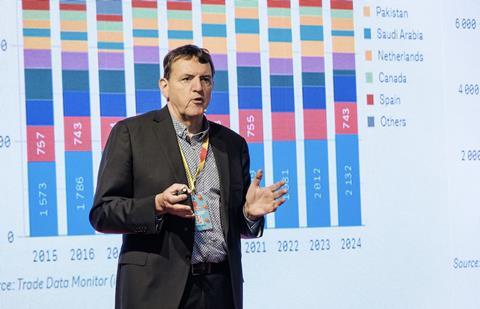Faced with new challenges, some foresee the increasing commoditisation of fresh tomatoes, despite continued success for premium varieties

Analysing the tomato market from a consumer perspective can be a complex task, such is its breadth. While some shop for the cheapest tomato available, others seek out premium, on-the-vine, taste-the-difference luxury. For most, of course, the decision rests largely on whether the tomatoes are to be eaten as a snack, in a salad or hidden in a sauce.
As delegates heard at the Fruitnet Tomato Congress in Malaga on 11 November, not only do tastebuds, uses and budgets differ when it comes to tomatoes, but what’s considered premium is also constantly evolving.
“The attributes required to be premium are gradually increasing in the eyes of consumers,” stated David del Pino of Spanish consultancy Freshtrategy. “In order to have an impact today, the product has to be exceptional, or at least something consumers are really drawn to or attracted by.”
For Alberto Cuadrado Salmeron of Dutch breeder Rijk Zwaan, whether a tomato is premium or not has a lot to with the market it is being sold in. “The important thing is that your product is placed correctly,” he said. “We have to fill the different SKUs on the retail shelves, so we need varieties that prioritise taste, as well as ones you can purchase for just €4 per kilogram.”
Del Pino said consistency remains key. “The taste can be excellent in February or March, but if you don’t maintain that quality throughout the season, the claim of premium may mislead and put consumers off,” he warned.
It is partly because of this versatility that Lambert van Horen of Rabobank views the tomato market as “robust”, in spite of the economic challenges. “It is changing rather than growing,” he clarified. “The market has evolved in recent years to become more about value than volume.”
“The middle class is not disappearing but their behaviour has changed completely,” added Del Pino. “We have a split between those who look for tomatoes as a commodity and those who look for the specialties. If I had to make a call, with the problems concerning inputs, labour, inflation and ageing populations, I would say commodity tomatoes may make a big comeback.”
Opportunity amid challenges
When it comes to environmental challenges and labour issues, Van Horen sees opportunities for suppliers, breeders and technology companies to co-create new solutions.
“There will be solutions coming from the breeding companies,” confirmed Cuadrado. “We are breeding for new climates, selecting the genotypes for these new conditions, but it will take time. We need to select the varieties for local conditions so we need to know where the tomatoes of tomorrow will be produced.”
Van Horen pointed to the impact of climate change on crop production, in the form of droughts, heat waves, and more frequent and devastating hailstorms. “In coffee, we are seeing changes in production zones,” he said. “In pears, production in Europe is moving northwards. So the climate is affecting many crops. Thankfully, the tomato sector has more ways to adapt to climate change due to the use of greenhouses, irrigation systems, substrates, et cetera.”

But as with most products, Van Horen revealed, tomato production is currently not growing as fast as the global population, indicating a future shift in supply-demand dynamics.
“In North America, tomato production is declining,” he said. “When there is water scarcity, there is also increased competition between crops in those areas. So whether a grower produces tomatoes or oranges will depend on which of the two crops will have a higher profitability in order to pay for the water that is required.”
Van Horen sees developments such as robots and AI as a big help for the future of the sector – in harvesting, in better managing supplies, in reducing food waste and in maximising returns for growers.
“There must be a combined solution,” concluded Cuadrado. “We need more control over the environment in which our tomatoes are grown, so better, more advanced greenhouses will be necessary. From the breeding perspective, we need to select not the best variety for certain conditions, but the optimal variety for different conditions. Problems like viruses and pests are worsening due to climate change, so we need to provide a solution for the producer.”
Part of that solution is ensuring a wide choice of tomato varieties is available to growers. Whether those varieties are regarded as commodities or premium products will depend heavily on the future environment in which they are both produced and sold.



